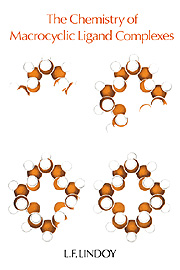Book contents
- Frontmatter
- Contents
- Preface
- 1 What is different about macrocyclic ligand complexes?
- 2 Synthetic procedures
- 3 Macrocyclic systems – some further categories
- 4 The metal-ion chemistry of polyether and related macrocyclic systems
- 5 Host-guest chemistry: macrocyclic hosts and non-metallic guests
- 6 Thermodynamic considerations
- 7 Kinetic and mechanistic considerations
- 8 Redox properties
- 9 The natural macrocycles
- References
- Index
4 - The metal-ion chemistry of polyether and related macrocyclic systems
Published online by Cambridge University Press: 08 October 2009
- Frontmatter
- Contents
- Preface
- 1 What is different about macrocyclic ligand complexes?
- 2 Synthetic procedures
- 3 Macrocyclic systems – some further categories
- 4 The metal-ion chemistry of polyether and related macrocyclic systems
- 5 Host-guest chemistry: macrocyclic hosts and non-metallic guests
- 6 Thermodynamic considerations
- 7 Kinetic and mechanistic considerations
- 8 Redox properties
- 9 The natural macrocycles
- References
- Index
Summary
The crown polyethers
Some preliminaries
The macrocycle types discussed so far tend to form very stable complexes with transition metal ions and, as mentioned previously, have properties which often resemble those of the naturally occurring porphyrins and corrins. The complexation behaviour of these macrocycles contrasts in a number of ways with that of the second major category of cyclic ligands – the ‘crown’ polyethers.
In 1967, a seminal paper describing the syntheses of thirty-three cyclic polyethers, of which (168)–(172) are typical, was published (Pedersen, 1967). All are simple monocyclic rings – a general macrocyclic category sometimes termed the coronands (Weber & Vogtle, 1980). In Pedersen's study, the first ligand to be prepared was (170) and because of the appearance of its molecular model and its ability, on coordination, to ‘crown’ a metal ion, this and other members of the series were referred to as crown compounds. The trivial names consist of, in order: (i) the number and kind of attached hydrocarbon rings, (ii) the number of atoms in the polyether ring, (iii) the class name, crown, and (iv) the number of oxygens in the polyether ring. Thus ligand (170) is referred to as dibenzo-18-crown-6.
Following the original paper, reports of the synthesis of new crowns and crown-like molecules proliferated. A typical property of these systems is their ability to form stable complexes with the alkali metal and alkaline earth ions.
- Type
- Chapter
- Information
- The Chemistry of Macrocyclic Ligand Complexes , pp. 90 - 135Publisher: Cambridge University PressPrint publication year: 1989



